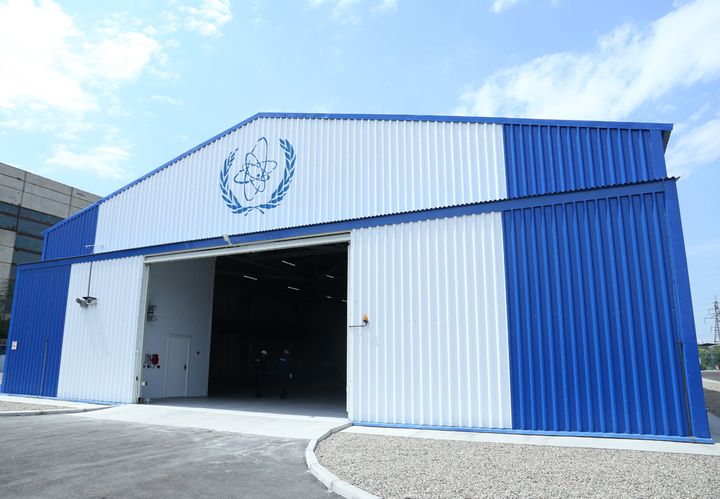
IAEA LEU Bank
As countries around the world adopt nuclear energy as a solution for both their climate change and economic development goals, the challenge of managing the spread of nuclear weapons continues to grow. Why? Because the same facilities needed to make low-enriched uranium to fuel a nuclear power plant also can be used to develop the highly enriched uranium needed to build a nuclear weapon.
Power-plant enrichment facilities have even been called “bomb starter kits,” and the ability to repurpose such facilities from exclusively peaceful purposes to illicit bomb-making operations is what led the international community to grapple with Iran and its nuclear program for so many years.
Today, the world needs a new framework for producing nuclear fuel for civilian energy programs that is safer, more secure, and prevents the misuse of nuclear energy facilities for weapons.
This week, in an otherwise gloomy atmosphere of increasing nuclear risk, a big step toward a more secure nuclear future is taking place in Kazakhstan. The United Nations’ nuclear watchdog, the International Atomic Energy Agency (IAEA), is announcing the launch of a uranium bank to guarantee all countries access to nuclear fuel for their power programs, as long as they are in good standing with their nonproliferation obligations. The bank, officially called the IAEA Low-Enriched Uranium (LEU) Bank, creates an important option for countries that want the benefits of peaceful nuclear energy, without incurring the significant costs of developing indigenous uranium enrichment capabilities and without adding to the risks of global proliferation.
The bank will be owned and managed by the IAEA, making it the first of its kind not under control of any individual country (Russia and the U.S. currently own and operate similar banks) and the first to offer countries a guarantee of available fuel should other market supplies be disrupted. With an IAEA-run bank in place, countries can have full confidence that they can secure the materials needed to make fuel if they make the responsible choice not to develop that capability on their own.
The IAEA LEU Bank will operate much like your neighborhood banking branch. Ninety metric tons of LEU—the material basis for nuclear fuel—will be deposited by the IAEA at the bank, a physical reserve large enough to produce the fuel needed to power a large city for up to three years. The materials will be accessible to countries that are members of the IAEA but that have experienced an interruption in their acquisition of fuel on the commercial market. The country needing the LEU enters into a supply agreement with the IAEA and pays the full cost of restocking. Once the agreement is approved, the LEU will be shipped to a facility where it can be converted into nuclear fuel, following the highest international safety and security standards.
A country’s decision to rely on imported fuel, rather than to develop an indigenous enrichment capacity, may pivot on one point: whether or not there is a mechanism that guarantees an assured international supply of nuclear fuel on a non-discriminatory, nonpolitical basis to states that are meeting their nonproliferation obligations. The IAEA LEU Bank is just this mechanism.
With the LEU Bank, states can have confidence that their choice to rely on imported fuel supply will be secure, reliable, economical and in their best interest.
It is important to note that the IAEA LEU Bank does not seek to limit the rights of nations to pursue peaceful nuclear technology. From the start, the driving forces behind the bank focused on voluntary participation and national choice, and the IAEA has preserved this in the bank’s structure; the bank simply provides security of supply for countries that have made the decision to rely on commercial markets for their fuel.
The IAEA LEU bank started with a vision for a safer future from the Washington-based Nuclear Threat Initiative (NTI). With a generous $50 million investment from Warren Buffet, NTI jump-started development of the bank and helped secure support from around the globe. The facility is now being fully realized through the leadership of the IAEA, with an additional $100 million from influential donors including the United States, European Union, Kazakhstan, Kuwait, Norway, and the United Arab Emirates. Kazakhstan, long a nuclear security leader, volunteered to host the bank. This level of cooperation is rare in today’s world, and it has taken persistence, leadership and courage to come to fruition.
Beyond its practical implications, in a time of renewed fear of nuclear conflicts across the globe the bank projects a strong message that international cooperation can serve to reduce nuclear dangers and make the world safer. A key milestone for the bank came when the IAEA was able to secure transit agreements with China and Russia to ensure that the LEU, if needed, would be able to reach a fuel fabrication facility. This is a shining example where countries as traditionally adversarial as China, Russia and the United States have come to the table and pull the levers needed to turn an ambitious, mutually beneficial idea into a reality.
Of course, while the IAEA LEU Bank is well-positioned to make a material difference, it is by no means a cure-all in the pursuit of nonproliferation. Rather, it is our hope that it will serve as a safe and reliable option for countries venturing down the path of nuclear energy, so that future generations may live in a world free from the dangers posed by proliferation of enrichment capabilities. It is a $150 million dollar investment whose return could prove to be priceless.
